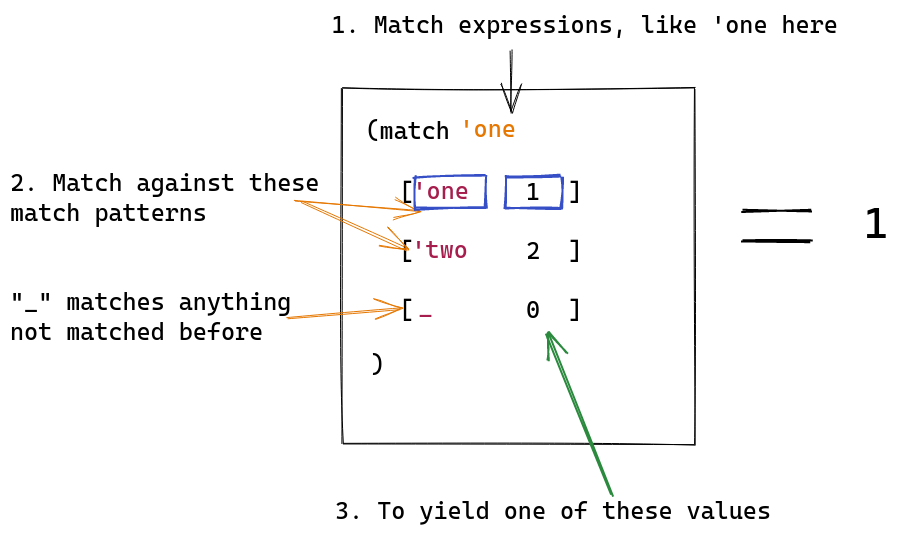Macros and metaprogramming
Macros are procedures that re-write code at compile time. Macros are a form of metaprogramming. Metaprogramming sounds really hard to understand, but it’s really just a program which can write other programs.
A metaprogramming example in Python
Here’s a quick example using Python, the language I’m most familiar with. It takes a number and generates code which prints every number from 0..number.
#!/usr/bin/env python
import sys
if __name__ == '__main__':
if len(sys.argv) < 2:
print("Usage: code-generate.py [number]")
sys.exit(1)
number = int(sys.argv[1])
out = [
f"print({num})"
for num in range(0, number)
]
print("; ".join(out))
You can then pass the output of this program to Python and run it.
$ python -c "$(python code-generate.py 4)"
0
1
2
3
Macros in Racket
Many languages have macros, but today I will be exploring how to use them in Racket.
To understand macros in Racket, there are two key concepts I needed to learn about first: Syntax objects and pattern matching.
Syntax objects
In the example I gave above in Python, I used a string template to create new code.
In Racket, macros accept and return something called a syntax object.
A syntax object is a piece of data which contains everything Racket needs to know about a piece of code in order to execute it, including:
- The literal code which is represented by the syntax object
- The location (line and column) and filename represented by the syntax object
- Optionally, data stored in syntax properties. I’m not sure what these are used for yet.
- Optionally, other syntax objects
Syntax objects can be instantiated using two forms, one is by using syntax and the other is by using the syntax prefix #'. Syntax can be inspected with the syntax->datum procedure.
> (define stx (syntax (+ 1 2)))
> (define stx2 #'(+ 1 2))
> (syntax->datum stx)
'(+ 1 2)
> (syntax->datum stx2)
'(+ 1 2)
For simplicity, we can think of syntax objects as just containers of code that can be manipulated like any other variable. We will be doing some manipulation of this code to produce other containers of code which are larger than the original.
Pattern matching
Pattern matching is the ability to match a pattern in code and do something useful with it.
In JavaScript, we can do pattern matching with a destructuring assignment:
> const [_, second, ...rest] = [1, 2, 3, 4, 5]
undefined
> console.log(`second: ${second} rest: ${rest}`)
second: 2 rest: 3,4,5
> const { a } = { a: 'hey!' }
undefined
> console.log(`a: ${a}`)
a: hey!
We can do similar things in Racket, using match:
> (match 'one
['one 1]
['two 2]
[_ 0]
)
1
Here’s an illustration I created to help me understand this:

In the above example, match 1 is called the “target expression” and the other lines like [1 "one"] are called the “pattern expression.” Lines in the pattern expression are laid out like this: [pattern-to-match-against pattern-expression].
We can also bind variables in the target expression to variables in the pattern expression, allowing us to perform more complex matches.
> (match '(5 5)
[(list x y) (+ x y)]
[(cons x y) (* y x)]
)
10
> (match '(5 . 5)
[(list x y) (+ x y)]
[(cons x y) (* y x)]
)
25
Macros don’t use this exact syntax, but they use something really similar. Knowing how pattern matching, and particularly how the value binding works, is crucial to understand macros.
Pattern matching on syntax objects
The first type of macros described in the Racket Guide are Pattern-Based Macros. These macros do the following:
- Accept a syntax object and match parts of it against a pattern
- Bind the matched parts to variables
- Uses the variables from step 2 in something called a template, which expands the matched code
One of the ways to define a macro is to use define-syntax and syntax-rules. Here define-syntax defines the name or id of the macro we are creating, and syntax-rules is where we put the pattern matching.
My first macro
I’m going to try to make a for..in loop macro using define-syntax and syntax-rules. I got the idea from the article Hygenic and referentially-transparent macros with syntax-rules.
Here’s what I hope to be able to compile and run once this is complete:
> (for item in '(1 2 3 4) (begin
(display item)
(newline)
))
1
2
3
4
Here’s the code I ended up getting to compile. It doesn’t quite work as I expect it too, so that will be something I look into tomorrow:
#lang racket
(define-syntax for
(syntax-rules (in) ; needed to match against for in
[(for item in list body ...)
(letrec ([for-in-helper (lambda (l)
(cond
((empty? l) '())
(else
(let ([item (car l)])
(cons body ... (for-in-helper (cdr l)))))))])
(for-in-helper list))]))
(let ([list '(1 2 3 4)])
(for item in list (begin
(display item)
(newline))))
But it compiles!